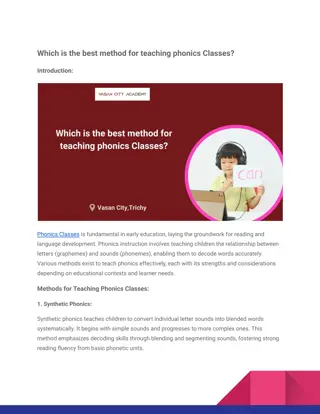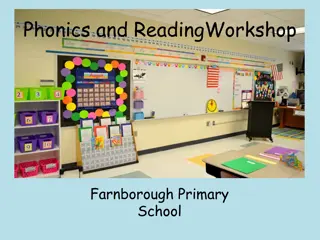
How are the common challenges students face in phonics classes addressed
Phonics classes in Trichy play a crucial role in helping young learners develop essential reading and writing skills. However, students often encounter various challenges during these classes that can affect their progress. Understanding these chall
Download Presentation

Please find below an Image/Link to download the presentation.
The content on the website is provided AS IS for your information and personal use only. It may not be sold, licensed, or shared on other websites without obtaining consent from the author. If you encounter any issues during the download, it is possible that the publisher has removed the file from their server.
You are allowed to download the files provided on this website for personal or commercial use, subject to the condition that they are used lawfully. All files are the property of their respective owners.
The content on the website is provided AS IS for your information and personal use only. It may not be sold, licensed, or shared on other websites without obtaining consent from the author.
E N D
Presentation Transcript
How are the common challenges students face in phonics classes addressed? Introduction Phonics classes in Trichy play a crucial role in helping young learners develop essential reading and writing skills. However, students often encounter various challenges during these classes that can affect their progress. Understanding these challenges and how they are addressed can help both educators and parents support children effectively. Common Challenges and Solutions One common challenge in phonics classes is difficulty with letter-sound correspondence. Some students struggle to match letters with their corresponding sounds, which can slow down their reading progress. To address this, educators use multisensory teaching methods. For instance, they might incorporate visual aids, auditory activities, and hands-on materials to reinforce letter-sound associations. Using interactive games and apps can also make learning more engaging.
Another challenge is difficulty with blending sounds. Blending involves combining individual sounds to form words, and some students find this process complex. Teachers address this by breaking down the blending process into smaller, manageable steps. They use techniques like segmenting (breaking words into individual sounds) and modeling blending aloud to help students practice. Repetition and gradual progression through increasingly complex words also aid in overcoming this difficulty. Spelling and writing difficulties are also common. Students may struggle with spelling due to a lack of phonemic awareness or difficulty with applying phonics rules. To support these students, teachers incorporate spelling activities that emphasize phonetic patterns. Dictation exercises, word-building games, and spelling tests help reinforce spelling rules and phonics knowledge. Attention and focus issues can impact students' ability to participate fully in phonics lessons. Young learners may become easily distracted or have trouble staying on task. To address this, teachers create a structured and engaging classroom environment with clear instructions and varied activities to maintain students' interest. Incorporating short, focused activities and providing regular breaks can also help improve attention spans. Difficulty with irregular words is another challenge. Not all words follow phonics rules, and students may struggle with words that don't fit standard patterns. Teachers address this by introducing sight word lists and contextual reading practices. Sight words are frequently used words that students are encouraged to recognize by sight rather than sound them out. Lack of motivation and confidence can also hinder progress. Some students may feel discouraged if they do not see immediate success or if they find phonics difficult. To build confidence, teachers provide positive reinforcement and celebrate small achievements. They also set achievable goals and offer consistent encouragement to help students stay motivated. Finally, parental involvement can vary, and some parents may not be familiar with phonics instruction techniques. To bridge this gap, educators offer workshops and resources for parents to learn how to support their child's phonics development at home. Providing parents with practical strategies and tools can enhance their ability to reinforce phonics skills outside the classroom.
Conclusion Phonics classes are essential for building foundational reading and writing skills, but students often face several challenges. By employing a range of strategies, including multisensory teaching methods, structured activities, and strong parental support, educators can effectively address these challenges. Understanding and addressing these common issues helps ensure that students make steady progress in their phonics development and build the confidence needed for successful reading and writing. For more information: Call us: +91 7010975193 Please mail us: sudhaacademy29@gmail.com Website:https://www.sudha-academy.com/






















